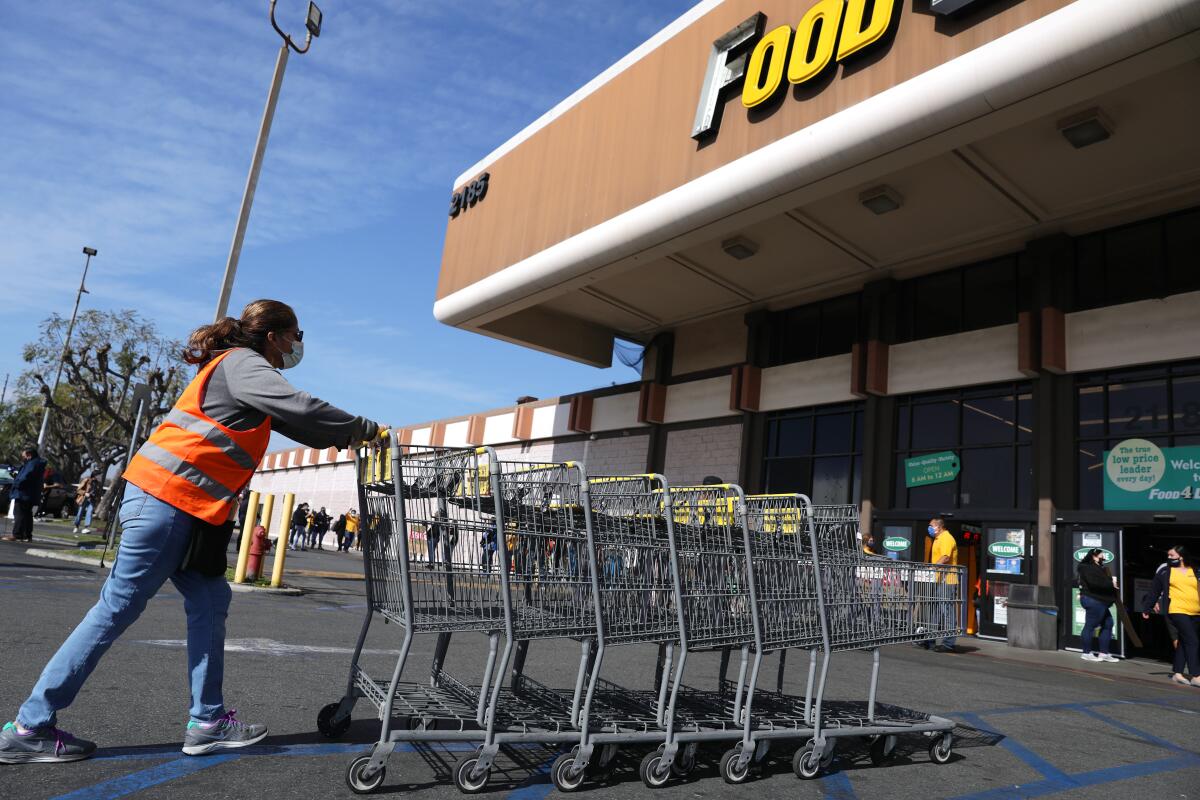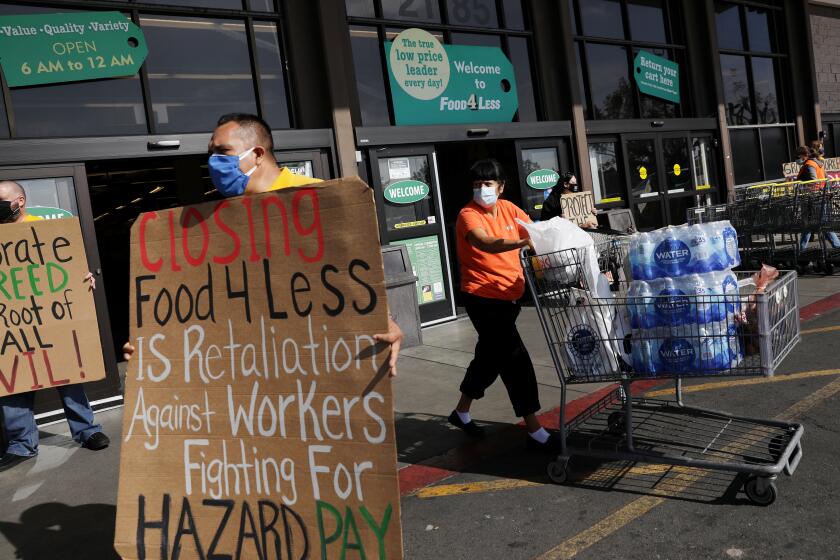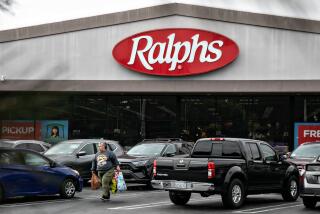2 out of 3 Kroger workers struggle to afford food and housing, survey finds

- Share via
More than two-thirds of Kroger workers struggle to afford food, housing or other basic needs due to low wages and part-time work schedules, a report published Tuesday by a Los Angeles-based research group found.
Fourteen percent of Kroger workers are homeless now or have been during the last year, according to the report.
Three-quarters are food insecure, meaning they lack access at all times to enough food for an active, healthy life, according to the definition set forth by the U.S. Department of Agriculture. That’s seven times the rate of food insecurity in the general population. Fourteen percent of workers report getting food stamps or food from a food bank or community donation program.
The Economic Roundtable group based its findings on a survey of more than 10,000 workers at Kroger-owned stores in Southern California, Colorado and Washington. The report was commissioned by several locals of the United Food and Commercial Workers International Union.
Adjusting for inflation, wages for the most experienced Kroger food clerks have declined between 11% and 22% across the regions surveyed since 1990, the report found. Kroger is the only employer for 86% of the workers surveyed.
Kroger spokesperson John Votava said Ralphs and Food 4 Less paid average compensation of more than $24 an hour to cover wages, healthcare and retirement benefits, compared with the $18-an-hour average compensation for U.S. retail workers.
In Southern California, Kroger operates more than 200 Food 4 Less and Ralphs locations. Workers, made available for comment by the UFCW union, say their wages and hours are unlivable.
Jeanne Olsen, a service deli employee, takes the bus from her home in La Crescenta to the Ralphs where she works in La Cañada Flintridge. Then, at 9 p.m. after her shift ends, she walks four miles home because she can’t afford a car, she said.
Olsen, who is supporting an 18-year-old son, supplements her income through recycling, which earns her an extra $100 to $150 in a good month.
“I pick up every can, every plastic bottle that I find and I have my family, extended family save for me and friends too,” Olsen, 59, said. “And I have to devote part of my apartment to that recycling … But without that I would not be able to be eat.”
For the record:
10:21 a.m. Jan. 11, 2022An earlier version of this article incorrectly stated Jeanne Olsen’s hourly pay rate as $14.25.
Olsen works six hours a day, six days a week, and made $14.90 an hour last year. Her pay rose to $15.90 at the start of the year.
“I don’t think that most of us are asking for anything more than just be paid what we’re worth, paid fairly,” Olsen said. “I shouldn’t have to struggle like I do.”
Food retailers expect record-breaking sales during the week of Christmas. Workers managing the holiday bustle are worrying about infections.
Workers’ problems have been exacerbated by the COVID-19 pandemic.
Robin White, who worked at a Ralphs in West Los Angeles, had her hours cut in half when the pandemic hit.
She could no longer afford rent and racked up more than $1,000 on her phone bill, which eventually went to collections. For a while, she slept in the car with her 9-year-old son, often in the parking lot at work.
Then she lost her car and moved in with her mother for a few months while trying to get it back.
“It’s a game, I guess, they play and they’ll give you an increase in pay like a dollar but then they’ll snatch hours,” White said. “So it’s like you still don’t make ends meet.”
White, 35, recently transferred to a store in Moreno Valley so she could stay with a cousin.
Workers also reported inadequate security and staffing in the stores, and a failure to enforce health standards such as social distancing and mask-wearing among customers.
Kroger is one of the largest grocery chains in the U.S. and was the 17th-largest corporation in terms of revenue in 2021.
The report was released ahead of upcoming negotiations between Kroger and the UFCW union, as the contract for roughly 33,000 workers in Southern California expires March 6. It called for an increase in the minimum pay for workers, doubling the share of workers with full-time jobs and adding worker-elected positions to the company’s board of directors to represent unionized employees, among other recommendations.
Negotiations have not gone smoothly as contracts expire in a number of regions in the country. Kroger workers in Oregon went on strike for a day in December 2021 before an agreement was reached. Workers in Houston authorized a strike a month before that but returned to the negotiating table before initiating it.
“Ralphs is committed to negotiating and reaching an agreement that significantly invests in our associates by putting more money in their pocket while maintaining affordable healthcare and a stable pension for retirement — a benefit that 93% of corporations no longer provide to their associates,” Votava said.
Kroger has previously pushed back aggressively against mandates by the city of Long Beach and L.A. requiring temporary $5-an-hour pay boosts for grocery workers amid the pandemic. In March 2021, the company closed three grocery stores in L.A., citing the “hero pay” mandate as a factor.
Burt P. Flickinger III, managing director of the retail consulting firm Strategic Resource Group, said grocery stores are “caught in in the proverbial crossfire of higher taxes from the county and the state, higher prices for their operating licenses and higher operating costs.”
Flickinger also pointed to revenue loss from retail theft, blaming Proposition 47, a 2014 voter-approved law that raised the minimum for charging property theft as a felony to $950 worth of merchandise.
Grocery outlets have pushed to increase penalties on shoplifting, with a 2020 survey by the National Retail Federation finding that theft was at an all-time high. The trade group said theft cost the industry $61.7 billion in fiscal year 2019, equal to 1.6% of retailers’ profits. The percentage stayed the same in 2021.
At a local level, property crime in Los Angeles is up 2.6% from last year, according to Los Angeles Police Department data published Nov. 27, but down 6.6% from 2019. The category that includes shoplifting — “personal/other theft” per LAPD — is down 32% from 2019.
Grocery stores have fared well during the pandemic as people have been eating more meals at home.
The country’s three largest grocery providers, Walmart, Kroger and Albertsons, earned an additional $6.8 billion in profit in the first three quarters of 2020 compared to 2019 — an average increase of 98%, according to a Brookings Institution report.
- Share via
Watch L.A. Times Today at 7 p.m. on Spectrum News 1 on Channel 1 or live stream on the Spectrum News App. Palos Verdes Peninsula and Orange County viewers can watch on Cox Systems on channel 99.
More to Read
Inside the business of entertainment
The Wide Shot brings you news, analysis and insights on everything from streaming wars to production — and what it all means for the future.
You may occasionally receive promotional content from the Los Angeles Times.













